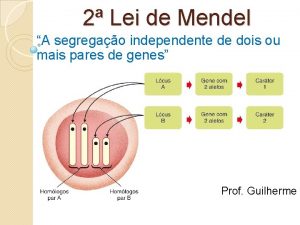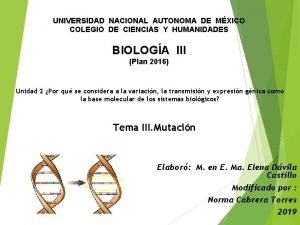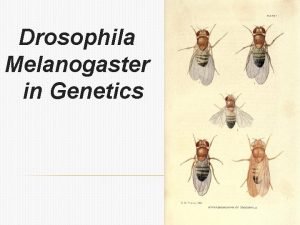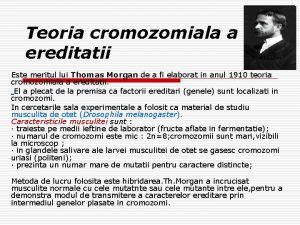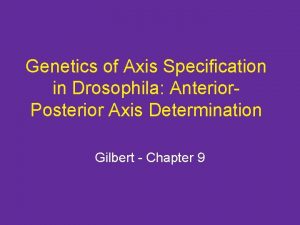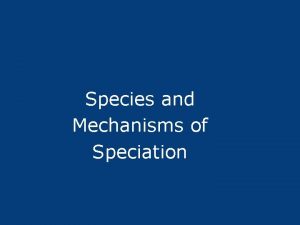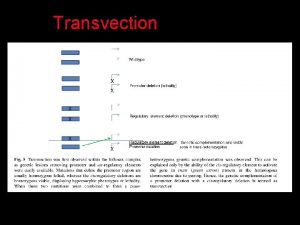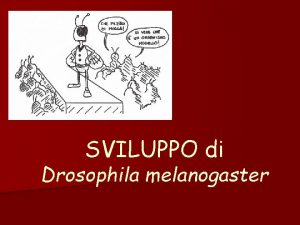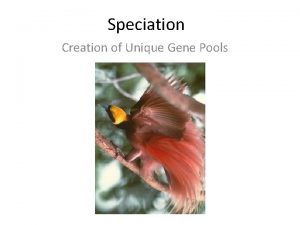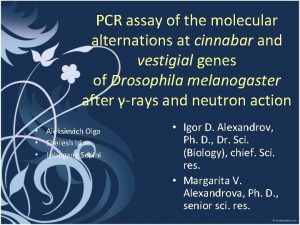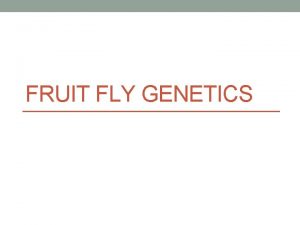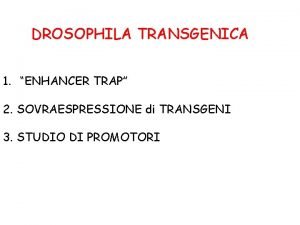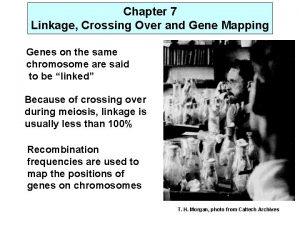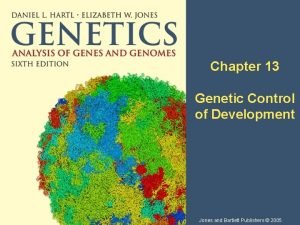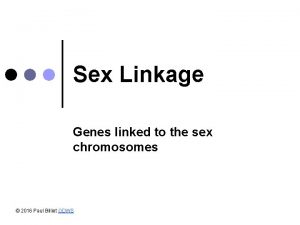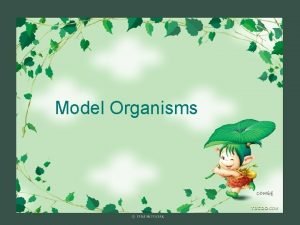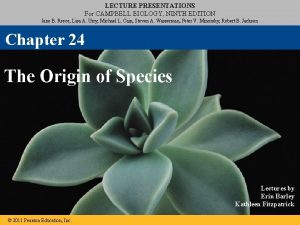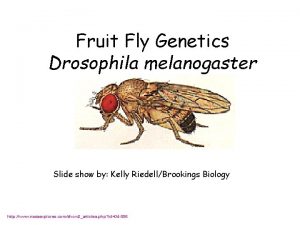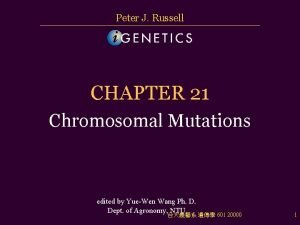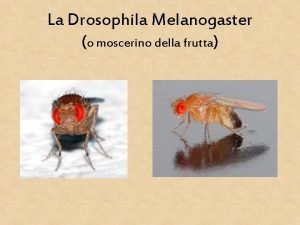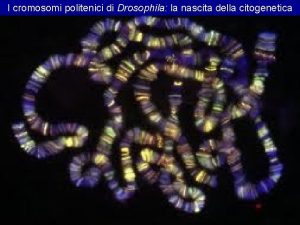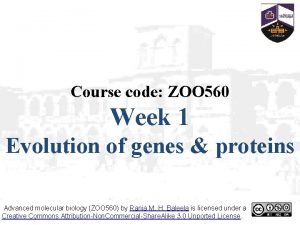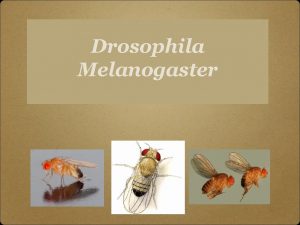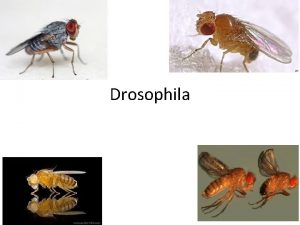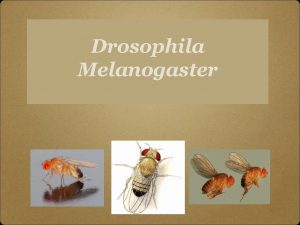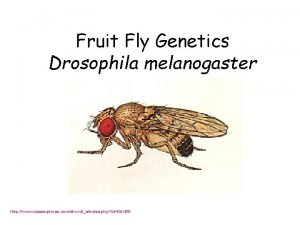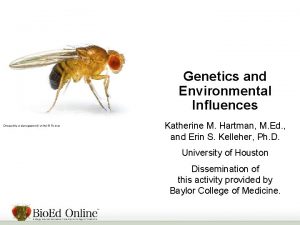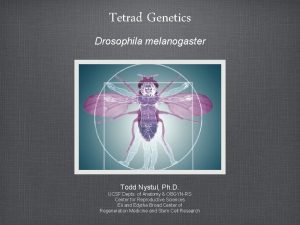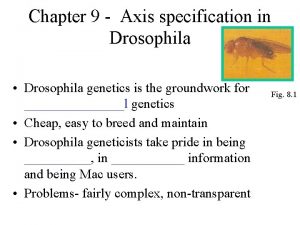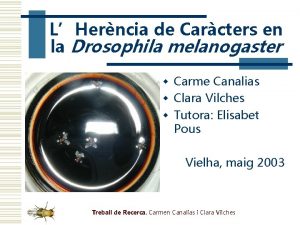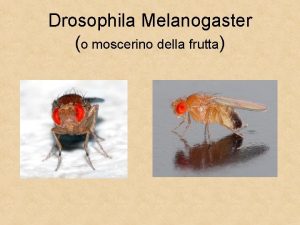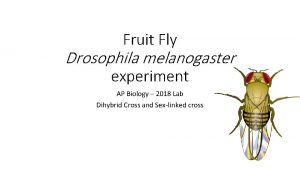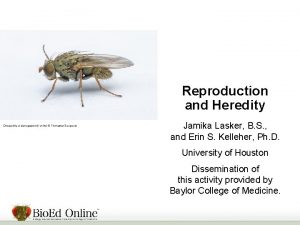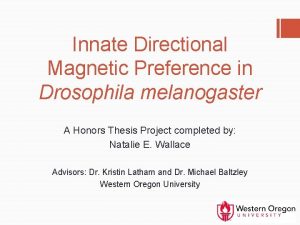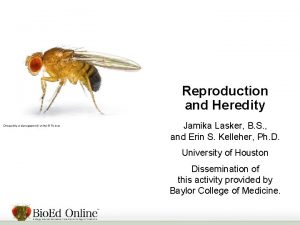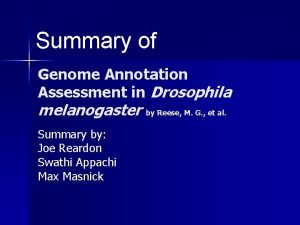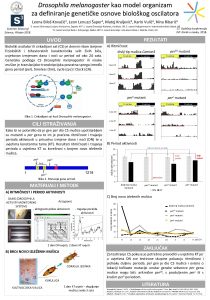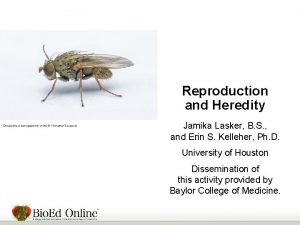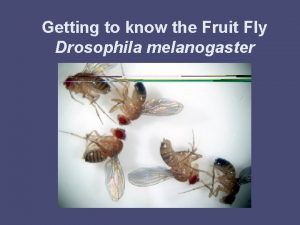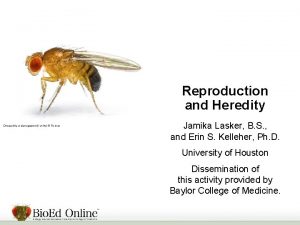Drosophila Melanogaster in Genetics Outline D melanogaster Definition


























- Slides: 26

Drosophila Melanogaster in Genetics

Outline D. melanogaster Definition D. melanogaster history of use in genetic analysis Advantages of using D. Melanogaster in Genetics D. Melanogaster chromosomes D. Melanogaster life cycle D. Melanogaster Anatomy D. Melanogaster mutations References

Outline D. melanogaster Definition D. melanogaster history of use in genetic analysis Advantages of using D. Melanogaster in Genetics D. Melanogaster chromosomes D. Melanogaster life cycle D. Melanogaster Anatomy D. Melanogaster mutations References

D. melanogaster Definition Drosophila Melanogaster is a species of fly in the family Drosophilidae. The species is known generally as the common fruit fly. Starting with Charles W. Woodworth's proposal of the use of this species as a model organism, D. melanogaster continues to be widely used for biological research.

Outline D. melanogaster Definition D. melanogaster history of use in genetic analysis Advantages of using D. Melanogaster in Genetics D. Melanogaster chromosomes D. Melanogaster life cycle D. Melanogaster Anatomy D. Melanogaster mutations References

D. melanogaster history of use in genetic analysis Charles William Woodworth (April 28, 1865 – November 19, 1940) He was the first person to breed the model organism Drosophila melanogaster (fruit fly) in captivity and to suggest to early genetic researchers at Harvard its use for

Outline D. melanogaster Definition D. melanogaster history of use in genetic analysis Advantages of using D. Melanogaster in Genetics D. Melanogaster chromosomes D. Melanogaster life cycle D. Melanogaster Anatomy D. Melanogaster mutations References

Advantages of using D. Melanogaster in Genetics Fruit flies breed quickly and cost almost nothing to grow Its easy to accelerate their growth (from egg to larvae for example) by introducing heat. The fruit flies have very large chromosomes (part of the DNA membrane) that can easily be studied via a microscope

Outline D. melanogaster Definition D. melanogaster history of use in genetic analysis Advantages of using D. Melanogaster in Genetics D. Melanogaster chromosomes D. Melanogaster life cycle D. Melanogaster Anatomy D. Melanogaster mutations References

D. Melanogaster chromosomes It has only four pairs of chromosome : A pair of sex chromosomes (two X chromosomes for females, one X and one Y for males), together designated Chromosome 1, along with three pairs of autosomes (non-sex chromosomes) labeled 2 through 4.

D. Melanogaster chromosomes

Outline D. melanogaster Definition D. melanogaster history of use in genetic analysis Advantages of using D. Melanogaster in Genetics D. Melanogaster chromosomes D. Melanogaster life cycle D. Melanogaster Anatomy D. Melanogaster mutations References

D. Melanogaster life cycle There are 4 stages in D. Melanogaster life cycle : 1. Egg : (Within 24 hours of laying, the eggs hatch) 2. Larva : (This stage take 5 days ) 3. Pupa : (This stage take 4 days ) in this stage, where the metamorphosis of D. melanogaster takes place, giving rise to wings and legs 4. Adult : Within 8 - 12 hours of emergence, the female fly is receptive. Then, it mates with the male Drosophila

D. Melanogaster life cycle

Outline D. melanogaster Definition D. melanogaster history of use in genetic analysis Advantages of using D. Melanogaster in Genetics D. Melanogaster chromosomes D. Melanogaster life cycle D. Melanogaster Anatomy D. Melanogaster mutations References

Drosophila Melanogaster Anatomy Regular fruit flies have red eyes and their bodies are generally a mixture between brown and yellow. Their general length is about 0. 3 cm. Usually the male fruit flies have a slightly darker body then the females. Another characteristic of the male fruit fly is a larger black spot on the abdomen, the male fruit flies are also slightly smaller than the females.

Drosophila Melanogaster Anatomy D. Melanogaster wild type

Outline D. melanogaster Definition D. melanogaster history of use in genetic analysis Advantages of using D. Melanogaster in Genetics D. Melanogaster chromosomes D. Melanogaster life cycle D. Melanogaster Anatomy D. Melanogaster mutations References

Drosophila Melanogaster mutations Common mutations that occur in D. Melanogaster : Short Winged Curly Winged Ebony White Eyed

Drosophila Melanogaster mutations Short Winged This mutation is a recessive trait, meaning that the fly won't express the gene unless it gets it from both parents. Unfortunately these fruit flies cannot fly.

Drosophila Melanogaster mutations Curly Winged This mutation is dominant so the fly only has to get it from one parent in order to express it. These flies are unable to fly but they can hop around.

Drosophila Melanogaster mutations Ebony This mutation is also recessive and causes these flies to have dark pigment built up all over their bodies.

Drosophila Melanogaster mutations White Eyed This mutation is recessive and on the sex chromosome, meaning that males and females have different numbers of copies of this gene. Like the orange eyed flies, these flies have normal eye sight, but one of The genes responsible for producing the wild-type red eyes is defective.

Drosophila Melanogaster mutations

Outline D. melanogaster Definition D. melanogaster history of use in genetic analysis Advantages of using D. Melanogaster in Genetics D. Melanogaster chromosomes D. Melanogaster life cycle D. Melanogaster Anatomy D. Melanogaster mutations References

References www. presentationszone. com www. wikibedia. org https: //biologywise. com http: //modencode. sciencemag. org www. thebugsquad. com www. unc. edu
 Em drosophila melanogaster asa vestigial curta
Em drosophila melanogaster asa vestigial curta Mutación por sustitución
Mutación por sustitución Drosophila melanogaster
Drosophila melanogaster Teoria cromozomiala a ereditatii morgan
Teoria cromozomiala a ereditatii morgan Genetics of axis specification in drosophila
Genetics of axis specification in drosophila Allopatric
Allopatric Hox gene mutation in drosophila
Hox gene mutation in drosophila Acron e telson
Acron e telson Hox gene mutation in drosophila
Hox gene mutation in drosophila Drosophila cinnabar
Drosophila cinnabar Sex
Sex Hereditary units
Hereditary units Difference between male and female drosophila
Difference between male and female drosophila Enhancer trap
Enhancer trap Elisanna intersex
Elisanna intersex Crossing over drosophila
Crossing over drosophila Imaginal discs drosophila
Imaginal discs drosophila Drosophila labelled diagram
Drosophila labelled diagram Drosophila
Drosophila Drosophila pseudoobscura
Drosophila pseudoobscura Vcise drosophila
Vcise drosophila Ovario drosophila
Ovario drosophila Drosophila pseudoobscura
Drosophila pseudoobscura Chromosome deletions
Chromosome deletions Esperimento morgan drosophila
Esperimento morgan drosophila Cromosomi politenici drosophila
Cromosomi politenici drosophila Bar eye in drosophila
Bar eye in drosophila
